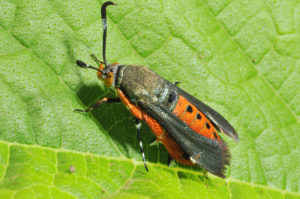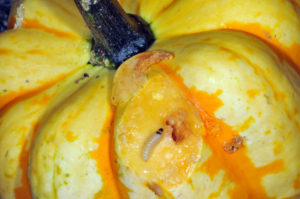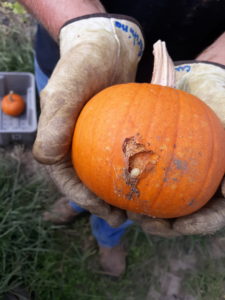Many of us may forget about the pesky squash vine borer until it’s too late. This pest of cucurbit crops tends to be sporadic in our region; you are either battling it every year or it hardly makes an appearance. The squash vine borer is a member of the clear-winged moths, a unique group of moths that are active during the daytime. They are very beautiful with their bright colored orange tufts on their legs (Figure 1), but can be devastating. The insect overwinters as a late instar larvae or pupa in the soil. When the weather warms, they mature and adults emerge. You can scout for the first generation of adults in the spring and should target pesticide applications at the base of the plant when adults are first spotted and for two weeks thereafter. If you wait, the eggs will hatch and the larvae will bore into the stem where they can no longer be reached with chemical applications. In spring, the larvae feed within the vines, resulting in wilt of the plant and plant death. The second generation, which can be found in late summer/early fall, feed in the ripening fruit (Figure 2 and 3). You can find holes in the fruit and sawdust-looking frass indicating larval infestation. At this point in the season chemical applications are not going to rescue the crop. To avoid damage next year, be sure to destroy crop residues and rotate away from infested areas. A diligent scouting program in combination with pheromone traps, can help detect adults during their mating flights and target application before the larvae hatch and bore into vines and fruit. As always, consult the Midwest Vegetable Production Guide (ID-56) when selecting a pesticide and be sure to check the label. Best of luck!


